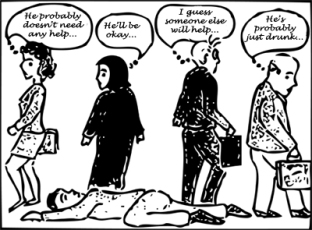Imagine that you walking down a relatively busy sidewalk with around forty people around. Suddenly a person attacks you and tries to rob you. Would you feel safer in this situation with forty people around as opposed to only one other person on the scene? Most people would answer yes to this question. However, psychologists John Darley and Bibb Latane found that the popular phrase “there is safety in numbers” is usually not a true statement during an emergency (Lilienfeld 140).
Darley and Latane connected the lack of intervention in these situations to diffusion of responsibility or people not realizing the magnitude of the situation. The conclusion that the more people present during emergencies lowers the probability of an individual providing aid became known as the bystander effect (Canada Safety Council). This effect is evident in a many horrific crimes. A well-known case is that of Kitty Genovese, who was murdered near her apartment in New York in 1968 while 38 people witnessed the crime, yet none of them helped her or called for help (Cox). If the bystander effect was not so prominent in society, Kitty Genovese could possibly be alive today. Another example of this effect is displayed in a more recent case in this video: http://abcnews.go.com/GMA/video?id=5012732. The clip portrays a man who is hit by a car and is not helped by anyone for a very long time.
The psychologists Latane and Darley conducted several “investigations” to gain scientific evidence to support the bystander effect. One study consisted of a woman experimenter taking individuals into a room for a survey and then entering an adjacent room with a ladder and books. Some participants were alone and others were in groups of two. Moments later, the woman staged herself falling from the ladder and crying out that she was injured. The results showed that, “When participants were alone, they offered help 70% of the time; when they had a partner, one or both of them did so only 40% of the time” (Lilienfeld 142). Latane and another psychologist Steve Nida compiled results from around 50 studies and found that when alone, participants intervene in emergencies 90% more than when in groups. These results are concrete evidence that the bystander effect is a real problem. There truly is not “safety in numbers.”
It is very important that the truth about this myth is unraveled. If the population is educated on the matter, then they will have the sense to intervene and help in an emergency. If not, then one may have to explain to the police and maybe even the victim’s loved ones why they just stood by and did nothing. Everyone should strive to be a good Samaritan and not a selfish bystander.
“Bystandereffect.” Cartoon. Kristina Mirasol. N.p., 13 Apr. 2012. Web. 24 Nov. 2013. <http://kristinamirasol.net/2012/04/13/the-bystander-effect-in-front-of-my-very-eyes/>.
Cox, Lauren, and Radha Chitale ABC News Medical Unit. “What Would You Do in a Hit and Run?” ABC News. ABC News Network, n.d. Web. 20 Nov. 2013.
“Don’t Just Stand There – Do Something.” Canada Safety Council. N.p., n.d. Web. 19 Nov. 2013.
Lilienfeld, Scott O. 50 Great Myths of Popular Psychology: Shattering Widespread Misconceptions about Human Behavior. Chichester, West Sussex: Wiley-Blackwell, 2010. Print.

